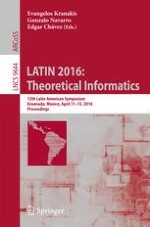This book constitutes the refereed proceedings of the 12th Latin American Symposium on Theoretical Informatics, LATIN 2016, held in Ensenada, Mexico, in April 2016.
The 52 papers presented together with 5 abstracts were carefully reviewed and selected from 131 submissions. The papers address a variety of topics in theoretical computer science with a certain focus on algorithms (approximation, online, randomized, algorithmic game theory, etc.), analytic combinatorics and analysis of algorithms, automata theory and formal languages, coding theory and data compression, combinatorial algorithms, combinatorial optimization, combinatorics and graph theory, complexity theory, computational algebra, computational biology, computational geometry, computational number theory, cryptology, databases and information retrieval, data structures, formal methods and security, Internet and the web, parallel and distributed computing, pattern matching, programming language theory, and random structures.
